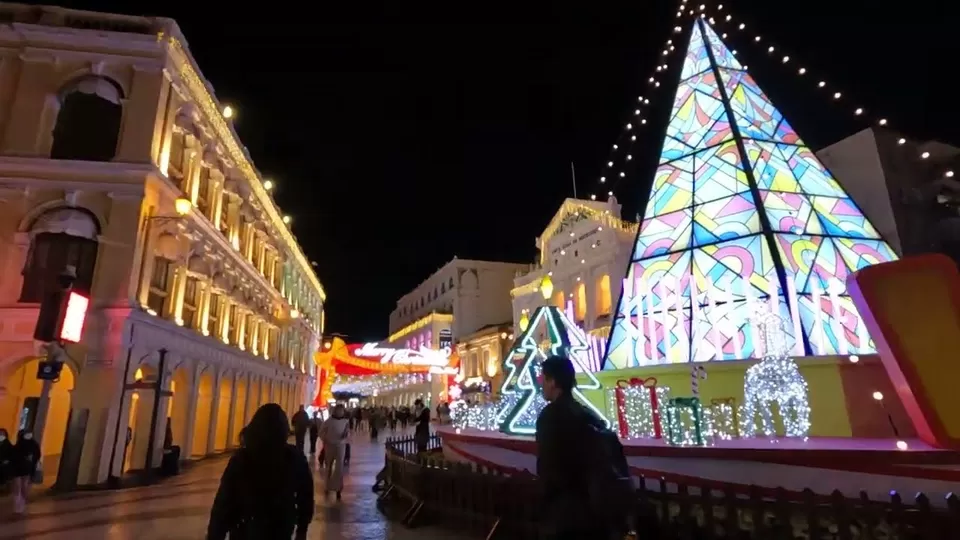Senado Square, also known as Largo Do Senado, is one of the most popular and iconic attractions in Macau. Located in the heart of the city, Senado Square is a part of the Historic Centre of Macao, a UNESCO World Heritage Site that showcases the unique fusion of Chinese and Portuguese cultures.
Senado Square is surrounded by magnificent colonial buildings, such as the Leal Senado Building, the St. Dominic’s Church, and the Holy House of Mercy, that reflect the rich history and heritage of Macau. Senado Square is also a lively and vibrant place, where you can enjoy the colorful festivals, shop for souvenirs, taste the local delicacies, and soak in the atmosphere of Macau’s historic and cultural heart.
How to Get to Senado Square
Senado Square is easily accessible from various points in Macau, such as the airport, the ferry terminal, the border gate, etc. You can choose from different modes of transportation, such as bus, taxi, or walking, depending on your preference and budget. Here are some of the ways to reach Senado Square:
By bus:
There are several bus routes that stop near Senado Square, such as 3, 3A, 4, 8A, 10, 10A, 11, 18, 19, 26A, and 33. You can check the bus schedules and fares on the official website of Macau’s Transport Bureau. The bus fare is usually around MOP 6 (USD 0.75) per trip.
By taxi:
You can also take a taxi to Senado Square, which is more convenient and faster, but also more expensive. The taxi fare from the airport to Senado Square is around MOP 80 (USD 10), from the ferry terminal is around MOP 40 (USD 5), and from the border gate is around MOP 50 (USD 6.25). You can find taxis at the designated taxi stands or hail one on the street. Make sure to have the address of Senado Square in Chinese, as some taxi drivers may not speak English.
By walking:
If you are feeling adventurous and want to explore the city on foot, you can also walk to Senado Square from nearby attractions, such as the Ruins of St. Paul’s Cathedral, the Monte Fort, or the A-Ma Temple. The walking distance is around 15 to 20 minutes, depending on your pace and route. You can follow the signs and the Portuguese pavement, which is a distinctive feature of Macau’s streets, to guide you to Senado Square.
What to See and Do at Senado Square
Senado Square is a place where you can see and do a lot of things, from admiring the architecture, to joining the festivities, to sampling the cuisine. Here are some of the main features and activities that you can enjoy at Senado Square:

Leal Senado Building:
This is the most prominent and oldest building in Senado Square, dating back to 1784. It was the seat of the Portuguese government in Macau, and its name means “Loyal Senate”, as it was the first institution to pledge allegiance to Portugal after the 1640 revolution. The building has a neoclassical facade, a courtyard garden, and a library that houses a collection of rare books and documents. The building is open to the public from 9 am to 9 pm, except on Mondays and public holidays.

St. Dominic’s Church:
This is a yellow and green Baroque-style church that was founded in 1587 by Spanish Dominican friars. It is one of the oldest and most beautiful churches in Macau, and it features a wooden ceiling, a carved altar, and a museum of sacred art. The church is open to the public from 10 am to 6 pm, except on Wednesdays.

Holy House of Mercy:
This is a white and pink building that was established in 1569 as a charitable institution to help the poor and the sick. It was also the first western-style medical clinic in Macau, and it served as an orphanage and a refuge for widows. The building now houses a museum that displays the history and the works of the Holy House of Mercy. The museum is open to the public from 10 am to 1 pm and from 2:30 pm to 5:30 pm, except on Mondays and public holidays.

Fountain:
This is a circular fountain that is located in the center of Senado Square. It was built in 1993, and it has a diameter of 16 meters. The fountain is decorated with blue and white tiles, and it has a wave shape that symbolizes the maritime history of Macau. The fountain is also a popular spot for taking photos, especially at night when it is illuminated by colorful lights.

Portuguese pavement:
This is a type of pavement that is made of small black and white stones that are arranged in patterns. It is a characteristic feature of Senado Square and other parts of Macau, and it reflects the Portuguese influence on the city. The pavement at Senado Square was laid in 1993, and it has a wave shape that matches the fountain. The pavement is also a cultural heritage, as it is made by skilled craftsmen who use traditional techniques and tools.
Pedestrian streets:
Senado Square is surrounded by pedestrian streets that are lined with shops, restaurants, and cafes. You can stroll along these streets and enjoy the lively and bustling atmosphere of Macau. You can also find a variety of souvenirs, such as clothes, accessories, antiques, and handicrafts, as well as local delicacies, such as egg tarts, almond cookies, pork chop buns, and milk tea. The pedestrian streets are open 24 hours a day, but the shops and restaurants may have different opening hours.

Festivals:
Senado Square is also a place where you can experience the festivals and celebrations of Macau, such as the Chinese New Year, the Dragon Boat Festival, the Mid-Autumn Festival, the Christmas, and the New Year. During these occasions, Senado Square is decorated with lanterns, flowers, banners, and lights, and it hosts various performances, parades, and fireworks. The festivals are a great way to witness the culture and the spirit of Macau, and to join the locals in their joy and excitement.
Other Attractions Near Senado Square
Senado Square is not the only attraction that you can visit in Macau. There are many other places that are worth seeing and exploring, especially if you are interested in the history, culture, and entertainment of the city. Here are some of the other attractions that are near Senado Square, and that you can easily reach by walking or by bus:
Ruins of St. Paul’s Cathedral:
This is the most famous landmark of Macau, and it consists of the stone facade and the staircase of a 17th-century Jesuit church that was destroyed by a fire in 1835. The facade is a masterpiece of Baroque art, and it features intricate carvings and statues of saints, angels, and symbols. The facade is also a symbol of the Christianization of Asia, and it is a part of the Historic Centre of Macao. The ruins are open to the public 24 hours a day, and they are free of charge.
Monte Fort:
This is a fort that was built by the Jesuits in the 17th century to defend Macau from pirates and invaders. It is the oldest and largest fort in Macau, and it covers an area of 10,000 square meters. The fort has four bastions, a cistern, a chapel, and a barracks, and it offers a panoramic view of the city and the sea. The fort is also a part of the Historic Centre of Macao, and it houses the Macau Museum, which showcases the history and the culture of Macau. The fort is open to the public from 7 am to 7 pm, and the museum is open from 10 am to 6 pm, except on Mondays. The admission fee for the museum is MOP 15 (USD 1.9) for adults, and MOP 8 (USD 1) for students and seniors.
A-Ma Temple:
This is a temple that was built in the 15th century to honor A-Ma, the goddess of the sea and the protector of fishermen and sailors. It is the oldest and most famous temple in Macau, and it is believed to be the origin of the city’s name. The temple consists of six sections, such as the Gate Pavilion, the Prayer Hall, the Memorial Arch, the Hall of Benevolence, the Hall of Guanyin, and the Zhengjiao Chanlin. The temple is also a part of the Historic Centre of Macao, and it showcases the diversity of religious beliefs and architectural styles in Macau. The temple is open to the public from 7 am to 6 pm, and it is free of charge.
Macau Tower:
This is a tower that was designed by the famous architect I.M. Pei, and it was completed in 2001. It is the tallest structure in Macau, and it stands at 338 meters high. The tower offers a stunning view of the city and the Pearl River Delta, and it also hosts various entertainment and leisure facilities, such as a revolving restaurant, a cinema, a shopping mall, a convention center, and an observation deck. The tower is also a hotspot for adventure seekers, as it features the world’s highest bungee jump, skywalk, skyjump, and tower climb. The tower is open to the public from 10 am to 10 pm on weekdays, and from 9 am to 10 pm on weekends and holidays. The admission fee for the observation deck is MOP 135 (USD 17) for adults, and MOP 70 (USD 8.75) for children and seniors.
Senado Square is a must-see attraction for anyone who visits Macau, as it offers a glimpse into the history, culture, and charm of the city. Senado Square is not only a place to admire the architecture and the heritage, but also a place to enjoy the festivals and the cuisine, and to explore the nearby attractions and activities. Senado Square is a place where you can experience the best of Macau, and where you can create unforgettable memories.
If you are interested in visiting Senado Square and other attractions in Macau, you can book a tour with Tripoto, the leading online travel platform that connects travelers with local experts and guides.
Tripoto offers a variety of tours that cater to different preferences and budgets, and that cover the most popular and hidden gems of Macau. You can also customize your own itinerary, and get personalized recommendations and tips from our experienced and friendly staff.








